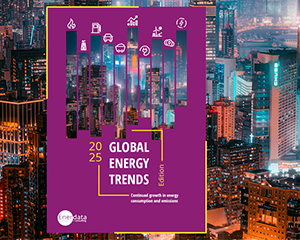전기 생산
2024년 세계 전력 생산량은 4.2% 성장했는데, 이는 2010~2019년 평균 성장률(+2.5%/년)보다 훨씬 빠른 속도입니다.
+7%
2024년 중국의 전력 생산량(세계 증가량의 절반)이 증가했습니다.
2024년 세계 전력 생산량은 4.2% 성장했는데, 이는 2010~2019년 평균 성장률(+2.5%/년)보다 훨씬 빠른 속도입니다.
2024년 세계 전력 생산량은 BRICS 국가(세계 발전량의 46%를 차지함, 강한 경제 성장 속에서 +6%), 미국(+3%), 유럽(+2%, 특히 프랑스와 튀르키예)에 의해 촉진되었습니다. 미국(주로 태양광과 풍력)과 유럽(프랑스: 원자력과 수력, 튀르키예: 수력)에서는 CO2 배출 제로 발전 비율이 더 높았습니다.
중국은 강력한 경제 성장, 증가하는 수요, 역동적인 재생 에너지 발전에 힘입어 2024년 세계 발전량 증가분의 절반을 단독으로 차지했습니다(+7%, 전 세계 발전량의 32%에 도달). 유사한 요인이 인도의 전력 생산량 증가(+4%)에 기여했습니다. 또한 브라질(+6%), 러시아(+2%), 남아프리카공화국(+5%, 석탄 화력 발전소 가용성 개선의 영향을 받음)에서도 발전량이 증가했습니다.
중동 지역의 전력 생산량은 약 6% 증가했는데, 특히 이란(+6%)과 사우디아라비아(+3%)의 성장세가 컸으며 아프리카 지역에서는 5% 이상 증가했습니다(이집트 6% 증가, 남아프리카 공화국에서는 크게 반등). 아시아 태평양 지역에서는 베트남, 인도네시아, 말레이시아에서 전력 생산량이 크기 증가한 반면에(각각 약 +11%, +6%). 반면, 한국(+1%), 호주(+2%), 일본(안정적)에서는 증가세가 훨씬 둔화되었습니다. 미국 지역에서는 멕시코의 2% 성장(주로 가스)이 캐나다의 1% 감소(수력 발전 감소)로 상쇄되었습니다.
국가 별 내역 (TWh)
세계
추세 1990 - 2024 - TWh
2025년 글로벌 에너지 동향은 핵심 에너지 데이터에 대한 인사이트를 제공합니다
우리는 이러한 결과를 장기적인 기후 목표와 관련하여 분석했습니다.
- 2050년 목표를 달성하기 위해 노력을 더 기울여야 할 지역은 어디입니까?
- 유럽이 파리협정 목표 달성에 어려움을 겪는 근본적인 원인은 무엇입니까?
- 기후 변화 완화에 실질적으로 기여하고 있는 지역은 어디입니까?
Need more data? All the information presented in this energy data tool are extracted from Global Energy & CO2 Data service, the most comprehensive and up-to-date database on all electricity production sources: hydro, nuclear, thermal, wind, solar, geothermal. Access to the whole electricity value chain information: production capacities by technology, power generation by technology, trade, prices, consumption per sector and indicators.
서비스 소개


